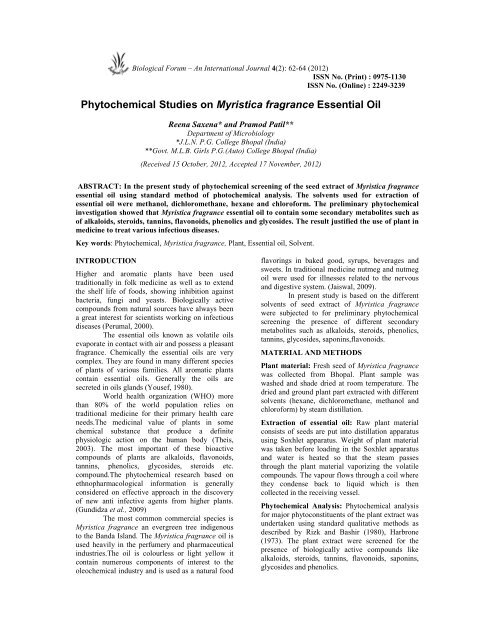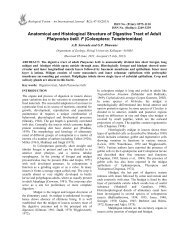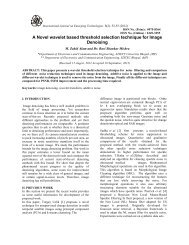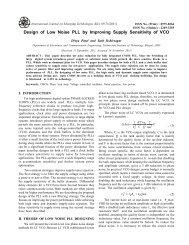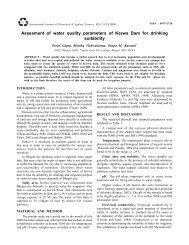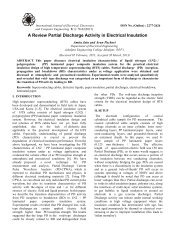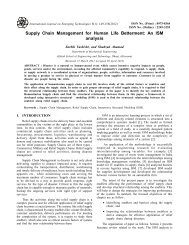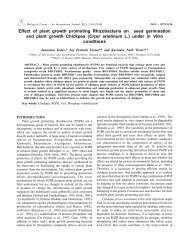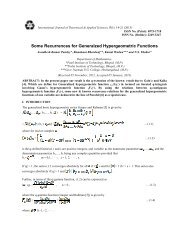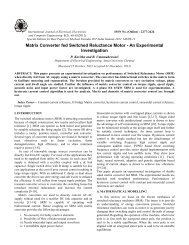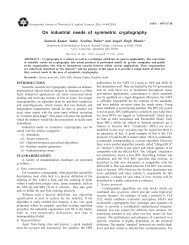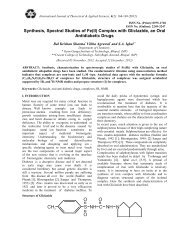Phytochemical Studies on Myristica fragrance Essential Oil
Phytochemical Studies on Myristica fragrance Essential Oil
Phytochemical Studies on Myristica fragrance Essential Oil
You also want an ePaper? Increase the reach of your titles
YUMPU automatically turns print PDFs into web optimized ePapers that Google loves.
Biological Forum – An Internati<strong>on</strong>al Journal 4(2): 62-64 (2012)<br />
ISSN No. (Print) : 0975-1130<br />
ISSN No. (Online) : 2249-3239<br />
<str<strong>on</strong>g>Phytochemical</str<strong>on</strong>g> <str<strong>on</strong>g>Studies</str<strong>on</strong>g> <strong>on</strong> <strong>Myristica</strong> <strong>fragrance</strong> <strong>Essential</strong> <strong>Oil</strong><br />
Reena Saxena* and Pramod Patil**<br />
Department of Microbiology<br />
*J.L.N. P.G. College Bhopal (India)<br />
**Govt. M.L.B. Girls P.G.(Auto) College Bhopal (India)<br />
(Received 15 October, 2012, Accepted 17 November, 2012)<br />
ABSTRACT: In the present study of phytochemical screening of the seed extract of <strong>Myristica</strong> <strong>fragrance</strong><br />
essential oil using standard method of photochemical analysis. The solvents used for extracti<strong>on</strong> of<br />
essential oil were methanol, dichloromethane, hexane and chloroform. The preliminary phytochemical<br />
investigati<strong>on</strong> showed that <strong>Myristica</strong> <strong>fragrance</strong> essential oil to c<strong>on</strong>tain some sec<strong>on</strong>dary metabolites such as<br />
of alkaloids, steroids, tannins, flav<strong>on</strong>oids, phenolics and glycosides. The result justified the use of plant in<br />
medicine to treat various infectious diseases.<br />
Key words: <str<strong>on</strong>g>Phytochemical</str<strong>on</strong>g>, <strong>Myristica</strong> <strong>fragrance</strong>, Plant, <strong>Essential</strong> oil, Solvent.<br />
INTRODUCTION<br />
Higher and aromatic plants have been used<br />
traditi<strong>on</strong>ally in folk medicine as well as to extend<br />
the shelf life of foods, showing inhibiti<strong>on</strong> against<br />
bacteria, fungi and yeasts. Biologically active<br />
compounds from natural sources have always been<br />
a great interest for scientists working <strong>on</strong> infectious<br />
diseases (Perumal, 2000).<br />
The essential oils known as volatile oils<br />
evaporate in c<strong>on</strong>tact with air and possess a pleasant<br />
<strong>fragrance</strong>. Chemically the essential oils are very<br />
complex. They are found in many different species<br />
of plants of various families. All aromatic plants<br />
c<strong>on</strong>tain essential oils. Generally the oils are<br />
secreted in oils glands (Yousef, 1980).<br />
World health organizati<strong>on</strong> (WHO) more<br />
than 80% of the world populati<strong>on</strong> relies <strong>on</strong><br />
traditi<strong>on</strong>al medicine for their primary health care<br />
needs.The medicinal value of plants in some<br />
chemical substance that produce a definite<br />
physiologic acti<strong>on</strong> <strong>on</strong> the human body (Theis,<br />
2003). The most important of these bioactive<br />
compounds of plants are alkaloids, flav<strong>on</strong>oids,<br />
tannins, phenolics, glycosides, steroids etc.<br />
compound.The phytochemical research based <strong>on</strong><br />
ethnopharmacological informati<strong>on</strong> is generally<br />
c<strong>on</strong>sidered <strong>on</strong> effective approach in the discovery<br />
of new anti infective agents from higher plants.<br />
(Gundidza et al., 2009)<br />
The most comm<strong>on</strong> commercial species is<br />
<strong>Myristica</strong> <strong>fragrance</strong> an evergreen tree indigenous<br />
to the Banda Island. The <strong>Myristica</strong> <strong>fragrance</strong> oil is<br />
used heavily in the perfumery and pharmaceutical<br />
industries.The oil is colourless or light yellow it<br />
c<strong>on</strong>tain numerous comp<strong>on</strong>ents of interest to the<br />
oleochemical industry and is used as a natural food<br />
flavorings in baked good, syrups, beverages and<br />
sweets. In traditi<strong>on</strong>al medicine nutmeg and nutmeg<br />
oil were used for illnesses related to the nervous<br />
and digestive system. (Jaiswal, 2009).<br />
In present study is based <strong>on</strong> the different<br />
solvents of seed extract of <strong>Myristica</strong> <strong>fragrance</strong><br />
were subjected to for preliminary phytochemical<br />
screening the presence of different sec<strong>on</strong>dary<br />
metabolites such as alkaloids, steroids, phenolics,<br />
tannins, glycosides, sap<strong>on</strong>ins,flav<strong>on</strong>oids.<br />
MATERIAL AND METHODS<br />
Plant material: Fresh seed of <strong>Myristica</strong> <strong>fragrance</strong><br />
was collected from Bhopal. Plant sample was<br />
washed and shade dried at room temperature. The<br />
dried and ground plant part extracted with different<br />
solvents (hexane, dichloromethane, methanol and<br />
chloroform) by steam distillati<strong>on</strong>.<br />
Extracti<strong>on</strong> of essential oil: Raw plant material<br />
c<strong>on</strong>sists of seeds are put into distillati<strong>on</strong> apparatus<br />
using Soxhlet apparatus. Weight of plant material<br />
was taken before loading in the Soxhlet apparatus<br />
and water is heated so that the steam passes<br />
through the plant material vaporizing the volatile<br />
compounds. The vapour flows through a coil where<br />
they c<strong>on</strong>dense back to liquid which is then<br />
collected in the receiving vessel.<br />
<str<strong>on</strong>g>Phytochemical</str<strong>on</strong>g> Analysis: <str<strong>on</strong>g>Phytochemical</str<strong>on</strong>g> analysis<br />
for major phytoc<strong>on</strong>stituents of the plant extract was<br />
undertaken using standard qualitative methods as<br />
described by Rizk and Bashir (1980), Harbr<strong>on</strong>e<br />
(1973). The plant extract were screened for the<br />
presence of biologically active compounds like<br />
alkaloids, steroids, tannins, flav<strong>on</strong>oids, sap<strong>on</strong>ins,<br />
glycosides and phenolics.
Identificati<strong>on</strong> test: The tests were d<strong>on</strong>e to find the<br />
presence of the active chemical c<strong>on</strong>stituents such as<br />
glycosides, phenolics, alkaloids, tannins,<br />
flav<strong>on</strong>oids, sap<strong>on</strong>ins and steroids by the following<br />
procedure.<br />
Test for alkaloids: 2ml filtrate was mixed with<br />
2ml of HCl and about 6 drops of Mayor’s reagents.<br />
A creamish or pale yellow precipitate indicated the<br />
presence of alkaloids.<br />
Test for steroids: 1ml of the solvent extract was<br />
dissolved in 2 ml of acetic anhydride was added to<br />
2 ml of H 2 SO 4 . The color changed from violet to<br />
blue or green in some samples indicating the<br />
presence of steroids.<br />
Test for tannins: 1 ml of the solvent extract was<br />
treated with few drops of 1% ferric chloride and<br />
observed for brownish green or a blue-black<br />
colorati<strong>on</strong>.<br />
Test for flav<strong>on</strong>oids: 4ml of filtrate was added to 5-<br />
6 drops of c<strong>on</strong>c. HCl and1.5 ml of methanol<br />
Saxena and Patil 63<br />
soluti<strong>on</strong>. Pink-tomato red color indicated the<br />
presence of flav<strong>on</strong>oids.<br />
Test for glycosides: Mix 2 ml solvent extract with<br />
2 ml chloroform. Add 2 ml acetic anhydride and 2<br />
drop C<strong>on</strong>c. H 2 SO 4 from the side of test tube. First<br />
red, then blue and finally green color appears.<br />
Test for Phenolics: 2ml ethanol was added to the<br />
test soluti<strong>on</strong> and few drops of ferric chloride<br />
soluti<strong>on</strong>. Blue colorati<strong>on</strong> indicates the presence of<br />
phenolics.<br />
Test for sap<strong>on</strong>ins: Froth test for sap<strong>on</strong>ins was<br />
used. 2ml of distilled water was added to 2ml of the<br />
test soluti<strong>on</strong> and shaked well and observed for<br />
forthing.<br />
RESULTS AND DISCUSSION<br />
<str<strong>on</strong>g>Phytochemical</str<strong>on</strong>g> screening of seed extracts: The<br />
preliminary phytochemical screening of the seed<br />
extract using different solvents was reported (Table<br />
1).<br />
Table 1: Preliminary phytochemical analysis of <strong>Myristica</strong> <strong>fragrance</strong> seed extracted with different solvents.<br />
Source Solvent Alkaloids Steroids Tannins Flav<strong>on</strong>oids Sap<strong>on</strong>ins Phenolics Glycosides<br />
<strong>Myristica</strong><br />
<strong>fragrance</strong><br />
Methanol<br />
Dichloromethane<br />
Hexane<br />
Chloroform<br />
+<br />
-<br />
-<br />
+<br />
+<br />
+<br />
+<br />
-<br />
-<br />
+<br />
+<br />
+<br />
-<br />
-<br />
+<br />
-<br />
-<br />
-<br />
-<br />
-<br />
-<br />
+<br />
-<br />
-<br />
+<br />
-<br />
-<br />
-<br />
Data presented in the table 1 showed results of<br />
methanol solvent seed extract of <strong>Myristica</strong><br />
<strong>fragrance</strong> essential oil showed the presence of<br />
alkaloids, steroids and glycosides. The<br />
dichloromethane solvent seed extract of <strong>Myristica</strong><br />
<strong>fragrance</strong> essential oil showed the presence of<br />
steroids, tannins and phenolics. The hexane solvent<br />
seed extract of <strong>Myristica</strong> <strong>fragrance</strong> essential oil<br />
was found to have steroids, tannins and flav<strong>on</strong>oids.<br />
The chloroform solvent seed extract of <strong>Myristica</strong><br />
<strong>fragrance</strong> essential oil was observed for the<br />
presence of alkaloids and tannins.<br />
<str<strong>on</strong>g>Phytochemical</str<strong>on</strong>g> is a natural bioactive<br />
compound found in plants such as vegetables,<br />
fruits, medicinal plants, flowers, leaves and roots<br />
that work with nutrients and fibers to act as an<br />
defense system against disease or more accurately,<br />
to protect against disease. Photochemical are<br />
+= Present, - = Absent<br />
divided into two groups which are primary and<br />
sec<strong>on</strong>dary c<strong>on</strong>stituents; according to their functi<strong>on</strong>s<br />
in plant metabolism. Primary c<strong>on</strong>stituents comprise<br />
comm<strong>on</strong> sugars, amino acids, proteins and<br />
chlorophyll while sec<strong>on</strong>dary c<strong>on</strong>stituents c<strong>on</strong>sists<br />
of alkaloids, terpenoids and phenolic compounds<br />
(Krishnaiah et al., 2007) and many more such as<br />
flav<strong>on</strong>oids, tannins and so <strong>on</strong>.<br />
The potential of higher plants as source<br />
for new drugs is still largely unexplored. Am<strong>on</strong>g<br />
the estimated 250,000-500,000 plant species <strong>on</strong>ly a<br />
smaller percentage has been investigated<br />
phytochemically and the fracti<strong>on</strong> submitted to<br />
biological or pharmacological screening as tool in<br />
discovering new biologically active molecule has<br />
been most protective in the area of antibiotics<br />
(Kroschwitz et al., 1992).
Saxena and Patil 64<br />
Many medicinal plants have been found<br />
effective in the cure of bacterial diseases. Due to<br />
increasing antibiotic resistance in microorganisms<br />
and side effect of synthetic antibiotics medicinal<br />
plants are now gaining popularity in the treatment of<br />
bacterial infecti<strong>on</strong>. Medicinal plants are c<strong>on</strong>sidered<br />
as clinically effective and safer alternative to the<br />
synthetic antibiotics (Pandy, 2010).<br />
As plants and their products are known to<br />
posses various sec<strong>on</strong>dary metabolites and also<br />
posses several lead phytochemical c<strong>on</strong>stituents such<br />
as alkaloids, steroids, tannins, flav<strong>on</strong>oids, sap<strong>on</strong>ins,<br />
phenolics and glycosides were identified from the<br />
plants. Plants based natural c<strong>on</strong>stituents can be<br />
derived from any part of the plants like bark, leaves,<br />
flowers, roots, seed etc. The use of plant plants<br />
extracts and phytochemical both with known<br />
antimicrobial properties can be of great significance<br />
in therapeutic treatments.<br />
Nutmeg is a small package with several big<br />
benefits. It’s used for preventi<strong>on</strong> and healing of<br />
many known c<strong>on</strong>diti<strong>on</strong>s. Here are some most<br />
comm<strong>on</strong> uses of nutmeg:<br />
Medically, nutmeg has str<strong>on</strong>g antibacterial<br />
properties. It is effective in killing a number of<br />
cavity-causing bacteria in the mouth. Like cloves;<br />
nutmeg c<strong>on</strong>tains eugenol, a compound that may<br />
benefit the heart. Myristicin found in nutmeg has<br />
been shown to inhibit an enzyme in the brain that<br />
c<strong>on</strong>tributes to Alzheimer’s disease and is used to<br />
improve memory. It is used in small dosages to<br />
reduce flatulence [excessive stomach or intestinal<br />
gas], aid digesti<strong>on</strong> and improve appetite. Nutmeg<br />
can help to combat asthma. It is also used to relax<br />
muscles. Nutmeg c<strong>on</strong>tains 10 per cent essential oil<br />
which is a colourless or light yellow liquid. The oil<br />
is obtained by the steam distillati<strong>on</strong> of ground<br />
nutmeg. Besides being used in toothpastes, cough<br />
syrups, perfumes and cosmetic industry, externally<br />
Nutmeg oil is mixed with alm<strong>on</strong>d oil and is used to<br />
relieve rheumatic pain.<br />
Nutmeg oil is used to treat toothaches.<br />
Drops of essential oil are put <strong>on</strong> cott<strong>on</strong> swab and<br />
applied to the gums around an aching tooth,<br />
sometimes also used to c<strong>on</strong>trol bad breath. Drops of<br />
nutmeg oil can also be mixed with h<strong>on</strong>ey to treat<br />
nausea, gastroenteritis, chr<strong>on</strong>ic, diarrhoea and<br />
indigesti<strong>on</strong>. In homoeopathy, nutmeg is used to treat<br />
anxiety and depressi<strong>on</strong>. In Chinese medicine, it is<br />
used to treat impotence and liver disease.<br />
<strong>Essential</strong> oils have been found useful in the<br />
various infectious diseases. <strong>Essential</strong> oils are rich<br />
source of antimicrobial agent. The therapeutic use of<br />
essential oils is becoming popular because of their<br />
lesser side effects and low resistance in<br />
microorganisms. In present study showed that the<br />
<strong>Myristica</strong> <strong>fragrance</strong> essential oil scientifically which<br />
have been used in traditi<strong>on</strong>al medicine to improve<br />
the quality of healthcare.<br />
CONCLUSION<br />
<str<strong>on</strong>g>Phytochemical</str<strong>on</strong>g> analysis showed the presence of<br />
effective biological compound like alkaloids,<br />
steroids, tannins, flav<strong>on</strong>oids, phenolics, glycosides<br />
in <strong>Myristica</strong> <strong>fragrance</strong> essential oil thus providing<br />
knowledge of the phytochemical metabolites.<br />
However, the present investigati<strong>on</strong> showed that most<br />
of the studied plants are potentially a good source of<br />
traditi<strong>on</strong>al medicine.<br />
REFERENCES<br />
A.M. Rizk and Bashir (1980). A. chemical survey of<br />
sixty plants. Journal of Fitoterpia, 53: 35-<br />
44.<br />
D. Krishnaiah, R. Sarbatly and A. B<strong>on</strong>o (2007).<br />
<str<strong>on</strong>g>Phytochemical</str<strong>on</strong>g> antioxidants for health and<br />
medicine – A move towards nature.<br />
Biotechnol. Mol. Biol. Rev. 1(4): 097-104.<br />
J.B. Harborne (1973). <str<strong>on</strong>g>Phytochemical</str<strong>on</strong>g> methods,<br />
L<strong>on</strong>d<strong>on</strong>. Chapman and Hall, Ltd. pp. 49-188.<br />
J.L.Kroschwitz and M. Howe- Grant (1992). Kirkothmer<br />
encyclopedia of chemical<br />
technology.2: 893.<br />
M., Gundidza, N., Gweru, M.L. Magwa, N.J.<br />
Ramalivhana, G. Humphrey, A. Samie, V.<br />
Mmbengwa (2009). <str<strong>on</strong>g>Phytochemical</str<strong>on</strong>g><br />
compositi<strong>on</strong> and biological activities of<br />
essential oil of Rhynchosia minima (L) (DC)<br />
(Fabaceae). African Journal of<br />
Biotechnology, 8(5): 721-724.<br />
N. Theis and M. Lerdau (2003). The evaluti<strong>on</strong> of<br />
functi<strong>on</strong> in plant sec<strong>on</strong>dary metabolites. Int.<br />
J. Plant. Sci., 164(3): S93-S102.<br />
P. Jaiswal, P. Kumar,V.K. Singhand, D.K. Singh<br />
(2009). Biological effect of <strong>Myristica</strong><br />
fragrans. ARBS Annual Review of<br />
Biomedical Sciences, 11: 21-29.<br />
R.R. Pandy, R.C. Dubey and S. Saini (2010).<br />
<str<strong>on</strong>g>Phytochemical</str<strong>on</strong>g> and antimicrobial studies <strong>on</strong><br />
essential oils of some aromatic plants.<br />
African Journal of Biotechnology, 9(28):<br />
4364 – 4368.<br />
R.T. Yousef and G.G. Tawil (1980). Antimicrobial<br />
activity of volatile oils. Die Pharmazie, 35:<br />
698–701.<br />
S.R. Perumal and S. Ignacimuthu (2000).<br />
Antibacterial activity of some medicinal<br />
plants from Eastern Ghats, South India. Solai<br />
Bull. Ethnopharmacol., 72: 39-41.


